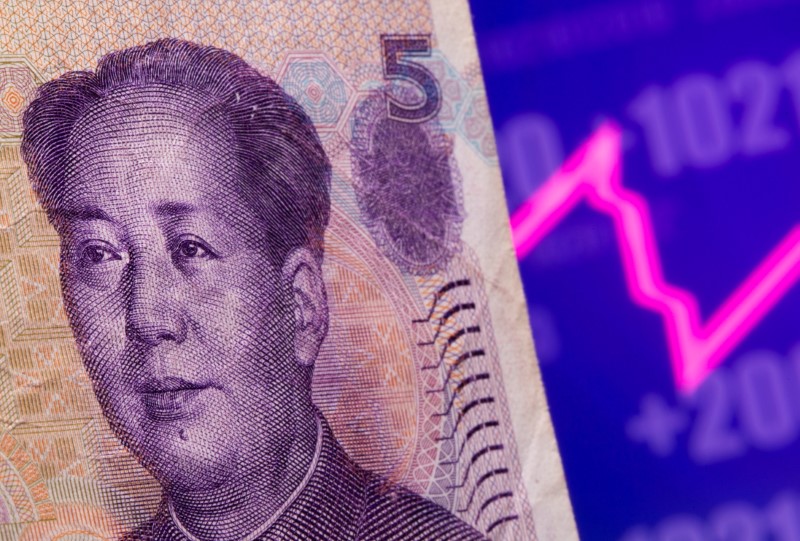(Reuters) – Investors remained bearish towards most Asian currencies, with the Thai baht faring the worst as economies across the region continued to struggle with Delta variant outbreaks, while strength in the dollar also weighed, a Reuters poll found.
Short bets were slightly raised on the Chinese yuan, Singapore dollar and the Indian rupee compared to two weeks ago, while they were mostly maintained on the Philippine peso and the Indonesian rupiah, a poll of 11 respondents showed.
Sentiment reversed on the Taiwanese dollar as investors went bullish on the currency for the first time since early July as strong exports data pointed to improved growth prospects.
The surge in cases of the Delta variant of the coronavirus is rattling parts of Asia, with Thailand and South Korea posting record daily infections, and sluggish vaccination programs further burdening their health infrastructures.
Regional currencies also fell out of favour as the dollar held a four-month peak after a recent run of strong jobs data fuelled expectations of earlier monetary policy tightening in the United States.
Bearish bets on the baht were at their highest since August 2015, after the Bank of Thailand last week downgraded the trade and tourism-reliant country’s growth forecast for the third time this year.
The baht has weakened more than 11% and is the worst performing currency in the region so far this year, while Thai stocks have shed almost 3.5% since the end of June.
“Domestically, the baht is at risk to another downgrade in Thailand’s outlook… which cannot be ruled out if the pandemic is not brought under control by early fourth quarter,” analysts at DBS said in a research note.
“Externally, the baht is not immune to the U.S. Federal Reserve’s hawkish tilt,” they added.
Investors slightly raised their short positions on the yuan, as recent economic indicators pointed to slowing economic growth, while China’s latest COVID-19 outbreak clouded the outlook.
While the yuan has been resilient compared to its peers in the last few weeks, China’s latest outbreak – now into its fourth week – threatens to curtail tourism and activity in the services sector.
Meanwhile, the Taiwan dollar was an outlier as strong exports data pointed to a brighter economic outlook. Exports rose for a 13th straight month to hit a record high in July, driven by manufacturers rushing to meet a global chip shortage.
The Reuters survey is focused on what analysts believe are the current market positions in nine Asian emerging market currencies: the Chinese yuan, South Korean won, Singapore dollar, Indonesian rupiah, Taiwan dollar, Indian rupee, Philippine peso, Malaysian ringgit and the Thai baht.
The poll uses estimates of net long or short positions on a scale of minus 3 to plus 3.
A score of plus 3 indicates the market is significantly long U.S. dollars. The figures included positions held through non-deliverable forwards (NDFs).
The survey findings ASIAPOSN are provided below (positions in U.S. dollar versus each currency):
DATE USD/C USD/K USD/S USD/I USD/T USD/I USD/M USD/P USD/TH
NY RW GD DR WD NR YR HP B
12/08 0.32 0.69 0.77 0.20 -0.09 0.37 1.39 1.17 1.75
29/07 0.27 0.78 0.71 0.27 0.36 0.29 1.4 1.21 1.49
15/07 -0.15 0.27 0.53 0.23 0.13 0.68 1.06 1.06 1.56
01/07 -0.29 -0.29 0.02 0.36 -0.19 0.5 0.49 -0.04 0.85
17/06 -0.63 -0.36 -0.49 -0.50 -0.58 -0.21 -0.05 -0.31 0.20
03/06 -1.34 -0.51 -0.55 -0.40 -0.44 -0.71 0.32 -0.66 0.37
20/05 -0.33 0.43 0.37 -0.06 0.33 -0.03 0.26 -0.22 0.81
06/05 -0.52 -0.39 -0.58 0.31 -0.59 0.86 -0.04 -0.35 0.50
22/04 -0.17 -0.23 -0.44 0.56 -0.38 0.75 -0.03 -0.37 0.58
08/04 0.72 0.48 0.30 0.59 0.77 0.20 0.46 0.36 0.91
25/03 0.30 0.65 0.46 0.45 0.50 0.05 0.54 0.11 0.54
(Reporting by Harish Sridharan in Bengaluru; Editing by Ana Nicolaci da Costa)

















